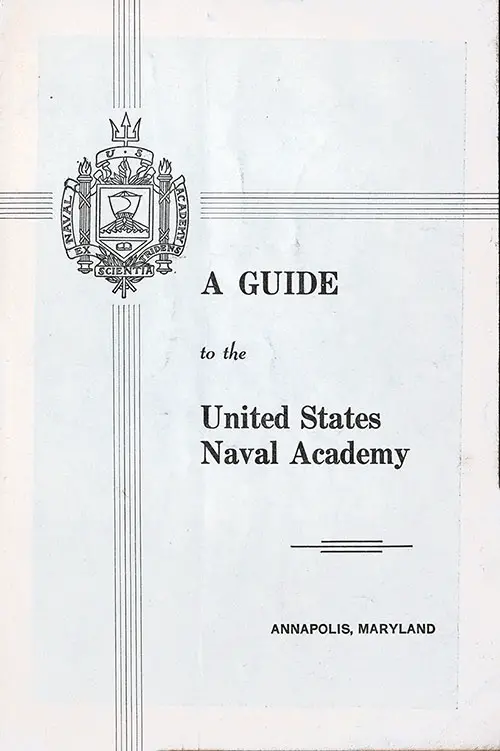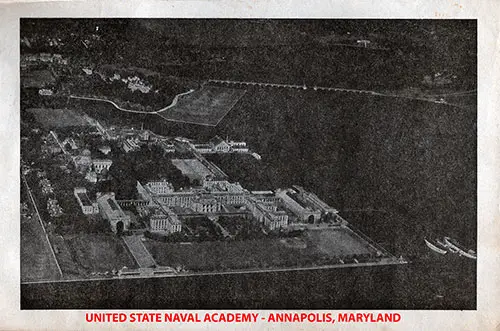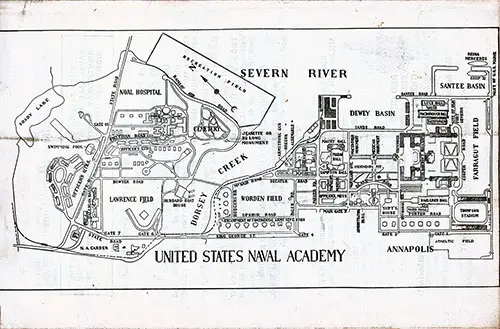A Guide to the United States Naval Academy - Annapolis, Maryland

Information for the Guidance of Visitors to the Naval Academy
This is your Naval Academy, to which we extend you a most hearty welcome. We regret that It is not possible to furnish you with a personal guide service. However, employing this folder, we Invite your attention to the major points of historical interest within the Academy walls so that your visit will be a memorable one.

GENERAL
The United States Naval Academy is maintained by the Federal Government, under the Bureau of Naval Personnel of the Navy Department, for the training and higher education of young men for the Naval Service. Its students have the rank of midshipman in the United States Navy. After completing the requirements of their four-year course, they are granted the degree of bachelor of science.
The mission of the Naval Academy Is: "Through study and practical Instruction to provide the midshipmen with basic education and knowledge of the naval profession; to develop them morally, mentally and physically; and by precept and example to indoctrinate them with the highest Ideals of duty, honor, and loyalty in order that the Naval Service may be provided with graduates who are capable Junior officers in whom has been developed the capacity and foundation for future development in mind and character leading toward a readiness to assume the highest responsibilities of citizenship and Government. "
Thus the Naval Academy develops self-sacrificing and devoted public servants, educated broadly so that they will become valuable citizens of their country, provided with scientific Insight built upon basic knowledge, endowed with qualities of leadership and character, and physically prepared so that they will have the rigor to carry out their tasks.
The Naval Academy is an undergraduate Institution closely integrated with the graduate schools In the Navy's overall educational pattern. It is the first step in the comprehensive educational system that extends throughout the naval officer's career.
HISTORICAL SKETCH
The United States Naval Academy was founded as the Naval School In 1846 by the Honorable George Bancroft, historian, educator, and Secretary of the Navy, to improve the then unsatisfactory methods of Instructing midshipmen. It was located in Annapolis. MD, on the site occupied by Fort Severn, which was given up for the purpose by the War Department.
At first, the course was five years, of which only the first and last were spent at the school, the Intervening three years being spent onboard ships on active service. It was reorganized in 1850-61 as the United States Naval Academy, with a course of study of four consecutive years.
A summer practice cruise replaced the omitted sea service and gave better opportunities for intensive training. During the Civil War, the Academy was moved to Newport, R. I., but was brought back to Annapolis In 1865, where it has since remained.
In the following years, significant Improvements were effected In the organization and curriculum. From 1873 to 1912, the academic course was six years, the last two of which were spent at sea. In 1912 the course was fixed at four years, the two years at sea being omitted.
During the Civil, Spanish-American, and World Wars, the course was shortened to provide more officers for the fleets. During the World Wars, large classes of reserve officers and reserve midshipmen were trained at the Academy.
Beginning in the year 1899, following an appropriation of $10,000,000 by Congress for the purpose, the Naval Academy was almost wholly rebuilt in the French Renaissance style after the architect's designs, Mr. Ernest Flagg, of New York.
The Academy's grounds now comprise about 235 acres, along the west bank of the Severn River, on which are 217 major buildings.
ANNAPOLIS AND THE NAVAL ACADEMY GROUNDS
Situated on the Severn River, where it flows into the Chesapeake Bay, the Naval Academy adjoins the old Colonial City of Annapolis. The citizens of Maryland's capital have safeguarded the many fine examples of Georgian architecture, the quaint, narrow streets, and cobblestone walks against the disenchantment of modernization.
The city, founded in 1649, has succeeded in maintaining its quiet way of life throughout the centuries. Water surrounds three-fourths of Annapolis. The shores of its creeks and Inlets are lined with privately owned pleasure craft, sailing and fishing being among the most popular forms of recreation.
It is only a step from the Old-World charm of Maryland Avenue into the imposing grounds of the Naval Academy.
The Naval Academy buildings are grouped around a quadrangle, called the Yard, bounded on the north by the academic group and on the south by the great granite dormitory, Bancroft Hail, named after George Bancroft, founder of the Naval Academy.
Starting at the Maryland Avenue Gate and turning right at Blake Road, one passes the ivy-covered Administration Building and then sees the Chapel with its vast dome before him.
Within the Chapel, where services are non-denominational and where over 2,000 midshipmen worship each Sunday, one's attention is drawn to the five great stained glass windows: Christ Walking on the Water, a memorial to David Dixon Porter, The Invisible Commission, the Sir Galahad window and the windows honoring our naval heroes. Admirals Farragut and Sampson.
In the crypt are contained the sarcophagus of John Paul Jones, with many historical relics and memorials. The anchors In front of the Chapel are from the armored cruiser NEW YORK, flagship of Admiral Sampson at the Battle of Santiago.
The mortars near the Chapel and nearly all the old Spanish bronze cannon around the Yard are trophies of the Mexican War.
Next door to the Chapel is the Superintendent's House, with Its lovely lawns, where the annual garden party for the graduating class is held. Across the street from these quarters stands Dahlgren Hall.
This building, named for the Civil War inventor of large caliber naval guns, houses the Department of Ordnance and Gunnery. Its great floor space is used for certain indoor athletics, as an auditorium, to accommodate brigade infantry formations, for the 10,000 or more visitors to the graduation exercises, and for the "Farewell Ball" of June Week.
West of this building is Ward Hall, a recitation building, and an Ordnance laboratory.
Along the south side of the Yard stands Bancroft Hall, housing the Brigade of Midshipmen. Its rotunda is decorated with murals depicting naval engagements. Its Memorial Hall displays Perry's battle flag at Lake Erie with the memorable words DON'T GIVE UP THE SHIP. From the Hall's windows, one may view Farragut Field, Thompson Stadium, the harbor, and the bay beyond.
Directly In front of Bancroft Hall is the statue of Tecumseh, a replica of the figurehead of the old ship DELAWARE. The next building toward the Severn is the gymnasium, Macdonough Hall, named for the victor of Lake Champlain.
Within are the athletic trophy room, handball and squash courts, instruction swimming pool, facilities for basketball, wrestling, boxing, fencing, and gymnastics. A section of this building, known as "Misery Hall," is occupied by the Athletic Medical Officer and his staff.
The offices of the athletic coaches and physical training instructors, who plan and conduct the extensive intramural program, are located on the second floor of this building. Immediately adjacent is the Natatorium, which contains one of the largest Indoor swimming pools in the country.
Along the seawall is Luce Hall, named for an early Head of the Department of Seamanship and writer of textbooks on that subject. In this hall are the Department of Seamanship and Navigation and the Department of Foreign Languages.
The Academic Group stands across the Yard to the north. Maury Hall, named for the distinguished oceanographer, Matthew Fontaine Maury, is occupied by the Departments of Mathematics, English, History, and Government. Sampson Hall, named for the Commander-in-Chief at the Battle of Santiago, contains the classrooms and laboratories of the Department of Electrical Engineering.
Mahan Hall, the middle or main building of the group, was named after the historian of the sea and houses the Library and the Auditorium.
Behind the Academic Group are Isherwood, Melville, and Griffin Halls, which contain the classrooms and laboratories of the Department of Marine Engineering and certain Electrical Engineering laboratories. These are adjacent to the parade ground, Worden Field.
Still farther to the north are Hubbard Hall (Boat House), Lawrence Field (baseball), and the Postgraduate School, with the Naval Hospital to the eastward along the river.
Completing the quadrangle of the Yard, near the Maryland Avenue Gate, are the buildings housing the Department of Aviation, the Museum, the Naval Academy Athletic Association, the U. S. Naval Institute, and the Officers' Club.
ADMINISTRATION
The Superintendent of the Naval Academy is Vice Admiral H. W. Hill, U. S. Navy.
The school's faculty is composed of approximately 450 members. Of these, 185 are civilians, with the academic rank of instructor, assistant professor, associate professor, professor, and senior professor, who staff in large part the academic and scientific-engineering departments. Administration and the professional departments are staffed almost entirely by line officers of the Navy.
EVENTS OF INTEREST
The general public is cordially invited to witness any of the following events characteristic of life at the Naval Academy.
Outdoor infantry drills are held beginning in March and continuing until late November. During the above seasons of the regular academic year, the entire Brigade drills at dress parades, Worden Field, on Wednesdays from 3:05 p. m. to 3:55 p. m., weather permitting. Brigade dress parades are also held during "June Week," usually the first week in June.
The Brigade marches to Chapel at 10:10 a. m. on Sundays. Throughout the year, weather permitting, the Brigade forms on the terrace in front of Bancroft Hall for muster at 12:05 p.m. weekdays, 12:15 p.m. Saturdays, and 12:30 p.m. Sundays and holidays.
Most athletic events are open to the public. On special occasions, tickets are required for admission.
Visiting Regulations
WHEN PASSING ON THE WALKS AND ROADS OF THE NAVAL ACADEMY, VISITORS ARE REQUESTED TO GIVE THE RIGHT-OF-WAY TO BOTH LARGE AND SMALL GROUPS OF MIDSHIPMEN MARCHING AS A UNIT.
Visitors are requested to observe the following regulations:
(a) Picnicking is not permitted.
(b) No smoking is permitted in buildings.
(c) Guides are not permitted to use megaphones.
(d) Visitors may take photographs of buildings' grounds and exterior views, but no interior pictures are permitted, nor can photos be taken for commercial purposes.
(e) Visitors in vehicles must enter the Naval Academy by the Maryland Avenue Gate (No. 3 Gate).
(f) Automobiles are allowed In the grounds from noon to 7:00 p.m. on Sundays and holidays to an extent determined by existing traffic conditions. A limited number is allowed on the grounds on other days.
(g) Motor coaches are not permitted on the grounds.
(h) Special traffic regulations are Issued for June Week and certain other events during the Academic Year.
Traffic Rules
The speed limit within the Naval Academy grounds is TWENTY MILES PER HOUR except where lower limits are posted.
PARKING
RED CURB — No Parking.
YELLOW CURB —Loading Zone.
GREEN CURB — Preferential Parking
(for persons specifically authorized).
NO PAINT ON CURB — Parking Allowed.
Use horns In emergencies only.
PEDESTRIANS HAVE THE RIGHT OF WAY
U. S. Naval Academy Press—9-12-50—10,000

